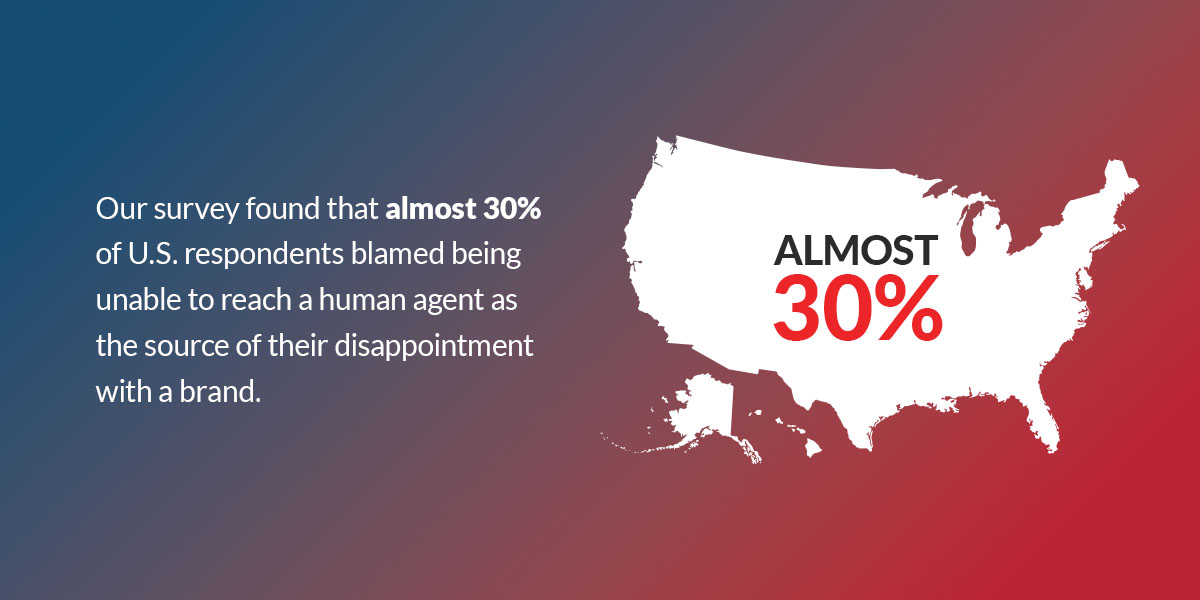Topics
Will AI Replace Customer Service?

Empowered with emerging technologies such as artificial intelligence (AI), machine learning (ML), big data and analytics, more organizations are engaging automation technology to achieve higher customer satisfaction. Chatbots are one of the tools extensively used in this pursuit and have shown tremendous growth in adoption in recent years. But the billion-dollar question being debated in boardrooms is whether chatbots can replace humans in the customer service domain.
To answer this question, CGS surveyed over 2,000 individuals from the U.S. and the U.K. to investigate their perspectives on chatbots in the customer service domain. This survey informed our 2020 customer service report and offered us some key insights on what the consumers want from chatbot technology.
The Role of AI in Customer Service
AI is a large umbrella that supports many tasks in the customer service process, from data analytics to customer-facing chatbots. Whether you use AI to support more efficient, accurate work from humans or automate time-consuming tasks entirely, the possibilities for AI in customer service are expansive.
Here are a few examples of how customer service and artificial intelligence come together:
- Chatbots: Chatbots are one of the most well-known uses of AI in customer service, leveraging natural language processing (NLP) tools to respond to customers instantly. Chatbots could offer basic responses or trigger workflows to automatically complete basic processes, like return requests, depending on the system’s complexity. Chatbots free up your team members and offer 24/7 instant responses for customers.
- Sentiment analysis: AI excels at making sense of large data pools. Sentiment analysis uses this ability to explore customer feedback across channels, like website reviews, social media comments and emails. It can help companies understand what customers want and identify areas for improvement or an attentive response.
- Predictive analytics: AI is also ideal for making predictions based on many data points, so it can help customer service teams anticipate customer behavior, such as when they’re likely to make a purchase or might need assistance. You could use predictive analytics to make suggestions to a customer, such as a related product, or identify a potential spike in support requests so that you can ramp up staffing.
- Task automation: With an automated workflow, AI tools can streamline repetitive and time-consuming processes like data entry and ticket routing. Instead of working on these tasks, your staff can focus on more complex, high-value interactions that demand the human touch.
Artificial intelligence is transforming contact centers, and the possibilities will only grow as AI technology evolves. We’ve already seen dramatic technological changes as developers hone AI models for different tasks.
Pros of AI in Customer Support
The pros and cons of artificial intelligence in customer service environments are also evolving alongside the technology itself. For example, chatbots have made great strides in showing empathy, reducing the risk of unpleasant customer experiences.
Some of the advantages of AI in customer support include:
Efficiency and Resource Management
As in many industries, AI is a significant time saver. By eliminating tasks like entering data and answering repetitive questions, AI customer service can reduce the workload for representatives and minimize processing delays. Customers also benefit from improved speed, particularly when engaging with chatbots who can help immediately.
Simple Scalability
In a volatile labor market, streamlining staffing requirements can help service teams stay flexible. Suppose your business grows quickly or you experience seasonal variation. In that case, AI customer support tools and automation allow you to pivot without complicated and time-consuming staffing requirements like hiring, training and benefits management.
Personalization
Personalized customer service is essential for many businesses, but offering a high level of attention is difficult with many customers, especially when each one uses numerous channels to engage with your brand. AI facilitates extreme personalization. It can:
- Assess many touchpoints to create accurate customer profiles.
- Make predictions about customers’ behavior or needs.
- Give agents the most relevant details for helping customers more effectively.
- Incorporate customer details, such as prior purchases or order tracking data, into chatbot conversations.
Drawbacks of AI Customer Service
Incorporating artificial intelligence and customer service has had its challenges, particularly for chatbot interactions. Fortunately, the technology is rapidly evolving to address these drawbacks.
Lack of Emotional Intelligence
One of the biggest barriers to implementing chatbots is consumer preference. Most customers prefer working with humans to chatbots, usually due to their ability to be empathetic and understanding, foster relationships and tackle more complex problems.
AI hasn’t always been able to replicate these behaviors, but language-learning models like ChatGPT have made great strides. Chatbots aside, AI’s many other uses can offer benefits without customer-facing conversations.
Issues With Complexity

Another common problem with AI is its ability to handle complex problems. Our survey found that almost 30% of U.S. respondents blamed being unable to reach a human agent as the source of their disappointment with a brand. Humans can use more problem-solving and critical-thinking capabilities to solve difficult problems in ways that AI is still learning to do.
While consumers typically prefer human agents, several variables impact their perceptions, such as the quality of the service provided. For example, when bots provided significantly faster yet accurate service, they scored higher than humans on satisfaction ratings. The study’s researchers suggest using chatbots where they clearly outperform humans, usually with simpler and narrowly defined tasks.
Data Privacy
Respondents also expressed serious concerns about the privacy of their information. While companies have taken bold initiatives to harness data through smart analytics for business intelligence, there have also been notorious cases of data breaches and corporate negligence as by-products. It is no wonder that consumers have justified concerns surrounding data security on their minds.
Over half the respondents to our survey were unsure or not confident about the safety of their data. They also wanted more transparency about how their data is used. For organizations, these concerns pose an immediate challenge of perception, where consumers feel fearful of having their data exposed and exploited. Enterprises must address these concerns by ensuring a robust data management strategy outlining how data is guarded.
Will AI Replace Customer Support?
Many wonder if AI will replace call center agents and other team members, but the research and trends point to a complementary approach. The human touch will always be necessary, bringing complex problem-solving, emotional connections and oversight to the experience. However, AI offers perks like speed and availability. The challenge for businesses is to combine them effectively and get the best of both worlds.
To go deeper into this issue, we asked some of the leading minds in the field of customer experience (CX) to share their reactions to the results and their insights on what the future holds at the convergence of technology and customer service. Our 2018 survey results indicated that consumers prefer human interactions over communicating with chatbots, under certain circumstances. While more than half the respondents agreed that chatbots ensure faster responses to service requests, they were not well equipped to deal with complex or unusual issues.
“I’m not surprised by the results at all,” said Adrian Swinscoe, independent advisor, speaker and best-selling author on customer experience consulting. “Customers have been telling brands for at least a couple of years now that they value the human touch or that they are regularly frustrated by their inability to speak to a real person when they encounter a problem that needs resolving.”
We still see significant variation in consumers’ comfort levels with AI across different use cases. People are often more comfortable using AI for tasks like ordering food and drinks or returning items than making investment decisions or accessing medical advice.
Finding Balance
Emphasizing the customer experience within AI initiatives is crucial, especially when you need to send a customer to an agent instead of having an AI bot forge ahead. For instance, customer service cases in health care are often complex and contain extremely personal and private details. So, when a customer has to deal with a bot incapable of offering empathy, patience and the information necessary and that only directs them to the FAQ, customer satisfaction can plummet.
Similarly, when organizations fail to unify their data from customers, customers often feel annoyed at having to repeat all their details to a human agent after having painstakingly typed it up in a chatbot interface. This failure to centralize customer service information in the backend leads to scenarios where customers are frustrated with extra effort resulting in a negative experience.
This repetition of effort is wearisome for the customer and wasteful from an organizational perspective. For businesses, the key to achieving successful solutions isn’t simply one of pure speed but also the overall experience they offer a customer, which can be vastly improved through a connected and channel-less experience.
“Speedy resolution is apparently the universal goal,” says Lynn Hunsaker, Chief Customer Officer at ClearAction Continuum. “Technologies will likely become ‘smarter’ and faster over time, and one of the keys to consumer adoption will be prevention of repetitive statements as one of the most exasperating aspects of customer service.”
The Future of AI and Customer Service
With these nuanced requirements, how can businesses merge AI in customer service environments? A thoughtful, well-crafted plan is essential for identifying where to use AI and how to integrate it with your workplace.
Creating a Smooth Transition
While AI has become a major tool in helping companies relate to their customers and boost CX, the report clearly shows a gulf in how various age groups react to this technology within the customer service paradigm.
In our 2018 survey, we found that 60% of U.S. respondents aged 35-44 years stated that companies are not transitioning to chatbots smoothly. The higher aged segments, constituted of Baby Boomers and Gen Xers, have their own reservations regarding this trend as well, believing that younger consumers may be adapting to this transformation better than them.
Overall, the report exhibited a general consensus that the shift towards chatbots was a case of “too much, too soon,” especially since most consumers are still accustomed to interacting with humans for resolutions and queries.
“Companies need to formulate a service and experience strategy that articulates what sort of service or experience they want to offer. Most don’t,” added Adrian. “However, doing so would help them decide what level of technology vs. human touch they should be applying across different parts of the customers’ journey and, also, how that should change for different types of customers.”

Age differences also affect AI acceptance. Older generations still seem hesitant, while Gen Zers show particular interest in AI tools and features.
Maintaining the Human Touch
While respondents seemed divided on the bot vs. man debate, nearly 75% of respondents to our 2018 survey agreed on one point: The idea of paying more to have human customer support agents is absurd. For modern consumers, the notion of human contact in customer service is self-evident and expected. And any attempt to charge them extra for this service would be widely unpopular and could elicit a major backlash.
Industry experts believe that while technology is a key driver of customer strategies, it is important for companies not to rush such evolutions against the will of their customer base. “Change takes time for people to embrace, commensurate with the gap between established, comfortable habits and a new thing,” added Lynn. “This study’s findings by age group underscore the need to understand and cater to various customer groups’ circumstances.”
Incorporating the human touch should also include transparency. Our 2020 survey showed that almost half of consumers wanted more transparency about how to get help from a human. In some situations, people even respond better to bots when companies are upfront about them — one study found that disclosing a chatbot’s identity as a bot made people more accepting of mistakes and promoted customer retention. Being transparent about AI and simplifying agent access are often essential elements of AI customer service.
Effective Digital Transformation
Technological transitions have to be seamless and in harmony with customer expectations if they are to be successful. A rapid transition may create short-term efficiencies and cost savings, but it can also put consumers off the brand. Any gains in ROI could be eaten up by repeat customer interactions and lower customer experience scores.
If an organization is truly primed to deploy new technology, then one of its primary steps needs to be in training people on how to use that technology effectively. Human agents must be taught the strengths and weaknesses of these new tools, and learn how to use technology to the best benefit of the customer service process. Despite how “smart” chatbots are or may get in the future, there will always be issues that are too complex, specific or sensitive for them to resolve.
It is, therefore, important that organizations realize, that when it comes to situations that require nuance and sensitivity, no one does it better than a real, live human being. And, while it may be tempting to manage the rising demand of customer service through automation, organizations need to ensure that consumers have easy and quick access to human agents who can step in to help.
Adrian adds, “Consumer preferences for customer service will change as the demographic ages and the level of digital maturity of customers increase. However, even digital natives want to speak to a human being when things get complicated. The assumptions that many brands make about what customers want are often wrong and they would do well to examine and test the assumptions that they are making.”
Ultimately, whether it’s a human or a bot, knowing the relevant details about a consumer enables organizations to serve them better and offer them solutions that work. For enterprises, this boils down to balancing their focus on the needs of digital transformation and the preferences of the consumer.
Organizations must ensure that their customers’ data security is never compromised as they gradually adapt to normalize chatbot technology within the customer service domain. Striking the right balance between personalization, data security and digital transformation is the key to a sustainable customer experience.
Technical Future-Proofing
As new technologies such as augmented reality (AR) and virtual reality (VR) bring the next wave of disruption to how we provide customer service, certain inherent truths will remain a constant.
Lynn offers a neat summary: “To provide exceptional customer service (i.e., maximize retention and lifetime value), companies should: (1) make it easy for consumers to choose the service mode they prefer; (2) minimize time lags and repetitive requests in every mode; and (3) most importantly, emphasize ownership of service issues by the management disciplines that originated the issues, in a wholehearted quest to better align the business with consumer expectations, anticipate consumers’ realities and reactions and prevent unnecessary burden on customer-facing roles and customers.”
Applying these rules to any new process or technology should help keep your organization focused on what’s most important: your customers.
Integrating AI and Customer Service With CGS
CGS is a global provider of enterprise learning, outsourcing services and business applications. You can read the full 2020 CGS customer service preferences report to discover more insights on consumer preferences for customer service engagements.
Since 1984, CGS has helped regional businesses, global enterprises and government agencies improve organization performance. CGS focuses on building comprehensive solutions to meet our clients’ complex needs and support their foundational operations.
With sophisticated AI and customer support services, our team is uniquely prepared to help businesses create an effective hybrid approach. Learn more about our services, or contact us to talk to a team member about a customer service and AI solution.


